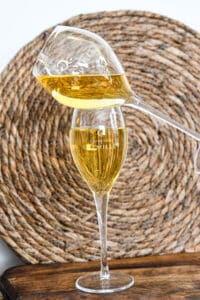
COMPOSITION OF CHAMPAGNE – OENOLOGICAL PARTICULARITIES
When discussing the composition of Champagne, one inevitably thinks of the three grape varieties that account for 99% of production: Pinot Noir, Meunier, and Chardonnay.
For many decades, the production of Champagne has followed a precise and well-established process. The making of Champagne respects traditions and practices, which Maison Gremillet presents to you here.
SUMMARY
– The Making of Champagne Begins in Our Hands
– The Alchemy of Champagne Production
– The Final Stages of Champagne Production

The Making of Champagne Begins in Our Hands
All Champagne producers take great care of their vines. Maison Gremillet tends to 50 hectares of vineyards in the Côte des Bar, in the southern part of the Champagne region. The making of Champagne begins with the grape harvest, which is always done by hand to show the utmost respect for the fruit. In fact, if you wish to participate in this first step, Maison Gremillet offers nighttime harvesting, creating memories that will last a lifetime! Next to the vineyard plots are the presses, just as Dom Pérignon, the first ambassador of Champagne, envisioned and implemented. The Champagnes in our various collections all come exclusively from the first pressing, known as the « cuvée. » The pressing of the grapes is the second step. All the grapes from the different grape varieties on our land, Pinot Noir and Chardonnay, are brought to the presses for juice extraction. Dom Pérignon had a good reason for installing the press close to the vines: to prevent the grape skins from coloring the juice. Once the pressing is complete, the natural sugars in the grape juice begin to transform into alcohol. Over about two weeks, the yeasts do their work. The transformation takes place by parcel and by grape variety. A “still” wine (non-sparkling) results from this process. For those curious to taste our still wine, the Rosé version with Rosé des Riceys or the Red version with Rouge de Balnot, both made from 100% Pinot Noir, will delight you.
As for the Champagne, the blending can now begin…
The Alchemy of Champagne Production
Harvesting, pressing, fermentation… what’s the next step in Champagne production? The magic of the process begins under the watchful and loving eye of the cellar master, Jean-Christophe Gremillet. Filtration, adding sugar if needed to help the drink reach the desired alcohol level, the wine must is monitored until it’s ready for… blending! Blending, as the name suggests, involves mixing various Champagne wines, clear wines, and reserve wines from previous years. Season after season, the goal is to maintain a specific heritage while bringing a new touch. The style and taste must be true to Gremillet Champagne. It’s a responsibility and a challenge… one that our cellar master takes on every year! This phase is incredibly important, during which several tasting committees, made up of oenologists and winemaker friends, share the honor of upholding the unique style and taste of Maison Gremillet! Next, bottling and the secondary fermentation, known as « prise de mousse, » will complete this blend, with the addition of the famous tirage liqueur, secret and unique, starting in January… We can only tell you that it consists of wine, sugar, and yeast. The bottles are then sealed, and the liqueur will cause a second fermentation inside the bottle, allowing the « prise de mousse » to occur. The wine slowly becomes Champagne. The bottles are then placed for a well-deserved rest of at least 15 months for non-vintage Brut Champagne, and at least 36 months for Vintage Champagne. Maison Gremillet is pleased to offer you its Brut Millésime 2017…
The Final Stages of Champagne Production
Deleted! After the « prise de mousse » stage, a sediment naturally forms in the bottle, adding complexity to the wine throughout its aging process. The next step is to remove this sediment by regularly turning the bottles in the cellar, with the goal of moving the sediment toward the neck. Then comes disgorgement! The neck of the bottle is plunged into cold to freeze the sediment. The bottle is then raised, uncapped… and the sediment is expelled by the pressure of the sparkling wine. This is known as « ice disgorgement, » invented by the Frenchman Armand Walfard (1854-1944). The vacuum created in the bottle is replaced by a dosage liqueur, also called the liqueur d’expédition. The sugar content in this liqueur will define the full designation of the Champagne:
For those curious about the secrets of making rosé Champagne, a forthcoming article will tell you more. The entire Gremillet family looks forward to welcoming enthusiasts who wish to delve deeper into this process at the estate!

When discussing the composition of Champagne, one inevitably thinks of the three grape varieties that account for 99% of production: Pinot Noir, Meunier, and Chardonnay.

For many decades, the production of Champagne has followed a precise and well-established process. The making of Champagne respects traditions and practices, which Maison Gremillet

Understanding the Difference Between Non-Vintage Brut Champagne and Vintage Champagne. The world of Champagne is vast and varied, offering a multitude of choices for wine